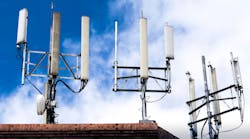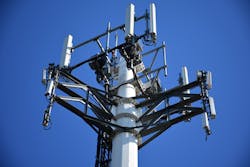Antenna arrays may not always receive the attention they deserve, but in many wireless-communications applications, they are the “silent enablers” that make the connection from one point to another. Each generation of wireless communications seems to be attempting a new, higher data rate along with its wireless voice and video capabilities, exacerbating the need for novel technologies such as multiple-input, multiple-output (MIMO) antenna techniques. In many ways, MIMO is a variation on the phased-array techniques that have long been successful in military electronic systems, including radars.
In its simplest form, MIMO technology amounts to cramming more than one compatible antenna into a package that’s meant for just a single antenna, increasing the information per bandwidth that can be sent across a wireless link. MIMO techniques make use of the natural multipath tendencies of radio waves when propagating from a transmitter to a receiver, so that the multipath effects are used to advantage, to strengthen signals, gain propagation distance, and increase communications system data rates.
As MIMO antenna designs are refined and their beam patterns optimized, more wireless users can benefit from a given amount of bandwidth. This is especially important as systems such as fifth-generation (5G) wireless reach to millimeter-wave frequencies in search of available bandwidth.
One key difference exists between traditional phased-array antenna systems typically associated with military applications and MIMO antennas: the phase shifts used to create the antenna patterns in phased arrays are performed by analog components, such as phase shifters, while beamforming with MIMO antennas is most often achieved with digital-signal-processing (DSP) techniques. Such use of DSP methods and the Eigen beamforming techniques of MIMO antennas can compensate for non-line-of-sight (NLOS) beam shifts and overcome the effects of multiple reflections in reconstructing an antenna’s beam pattern with a given number of antenna elements.
Why Go MIMO?
MIMO antennas were developed due to the large number of users expected in IEEE 802.11n wireless local-area networks (WLANs). Using multiple antennas in a single housing, or multiple-element MIMO antennas in a configuration that appears to be a single antenna, increases the data throughput and communications range of a WLAN compared to a network with a single antenna and the same radio transmit power. The use of a greater number of antenna elements or MIMO antennas also helps to minimize the effects of signal fading due to reflections and absorbed signals, compared to systems operating with a single antenna. The wireless-communications capacity of a WLAN can be increased by transmitting multiple data streams at the same time over MIMO antennas (Fig. 1).
1. The basic concept of a MIMO antenna is to pack multiple antenna elements, often at different frequencies, within a common antenna housing so that multiple antenna beams can move back and forth. (Courtesy of TELCO Antennas)
The basic idea of using spatial multiplexing with multiple transmitters and receivers and MIMO antennas involves the transmission of different streams of information with different antennas or antenna elements. A receiver with at least as many antennas or antenna elements as the transmitter can decipher that many streams of received data from the transmitter. This, in turn, increases the data flow through a system with a limited amount of bandwidth compared to a system with a single antenna. A 2 × 2 MIMO antenna can support two transmitters and two receivers, while a 4 × 4 MIMO system is able to transfer twice as much data, using four independent data streams, or four transmitters and four receivers.
Constant expansion of cellular communications and the advance of each cellular generation has also encouraged the use of MIMO antennas. Traditionally, cellular communications systems involved a single antenna on a telephone tower and base station and smaller antennas used within each user’s handset. As more internet services became handled by cellular, portable telephones, more capacity was needed by 3G and then 4G Long Term Evolution (LTE) cellular systems.
Increased capacity is a function of various parameters, including bandwidth, which is limited, but it’s achievable with more antennas or antenna elements, as in MIMO antennas. In appearance, whether at a base station or in a portable handset, a MIMO antenna appears much like a conventional antenna, whether it’s directional or omnidirectional in nature. However, it will provide multiple input/output ports in the form of connectors for its numerous internal antenna elements.
Base-station MIMO antennas (Fig. 2) are commonly used in 4G LTE wireless networks, IEEE 802.11n WLANs, and other wireless devices, with two or more antenna elements per housing. For a directional antenna configuration, such as a Yagi antenna in a 4G LTE system, at least two separate antennas must be within the housing to benefit from MIMO operation. In this case, the first antenna in an LTE installation is rotated to a 45-deg. angle while the second antenna is set at a 135-deg. angle, to gain the most benefits of the two separate antennas’ directional characteristics. Also, remember that LTE uses what’s known as polarization diversity to distinguish between the data streams passing between the two separate antenna elements.
2. Outdoor MIMO antenna arrays make it possible to achieve high data rates from limited-bandwidth channels.
The multiple antennas or antenna elements in a MIMO system enable several spatial degrees of freedom which are not possible in traditional single-input, single-output (SISO) antenna systems. Spatial degrees of freedom with the multiple antenna elements can be used for multiplexing or receiver diversity techniques, or a combination of the two, to help increase communications system capacity when the channel bandwidth is limited.
Selecting Speed
More antennas or antenna elements in a MIMO design usually translate into higher transmission/reception speeds for a WLAN modem. However, an IEEE 802.11n modem with the multiple antennas of a MIMO design must support all features of IEEE 802.11n for the highest speed possible. Commercial MIMO antennas are available with different numbers of antenna elements, allowing users to select different levels of MIMO benefits.
MIMO techniques enable antennas to combine multiple communications data streams from different signal paths and at different times. This use of spatial diversity takes advantage of any extra antennas in a system by means of receiver diversity techniques to increase the range of the communications system. Anytime the number of antennas in a system is more than the number of spatial streams, the system is a candidate for applying receiver spatial diversity.
For example, L-Com has developed a number of different MIMO antenna designs for use at 2.4 GHz and 4.9 to 5.8 GHz, with multiple dual-polarized antenna elements in each unit. The HyperLink HG2414DP-3NF is a three-element, flat-panel antenna that combines antenna elements with vertical and horizontal polarization and high gain for MIMO point-to-point and point-to-multipoint applications at 2.4 GHz. The antenna’s diversity radio capabilities allow for the interoperability of two radios on transmit and receive paths.
When more frequency coverage is required, more MIMO antenna elements can be combined as in L-Com’s four-element, dual-polarized HyperLink HG2458-13HDP-4NF MIMO antenna. It blends together two vertically polarized and two horizontally polarized dual-band antennas for use at 2.4 GHz and from 4.9 to 5.8 GHz in support of WLANs.
Modeling MIMO
As MIMO is applied to advanced communications systems, including emerging 5G wireless networks, modeling software provides a critical “first look” at how multiple antenna elements interact across many different frequencies, from RF through millimeter-wave frequencies. The Genesys and Momentum simulation software from Keysight Technologies, for example, are used for different aspects of MIMO antenna modeling, including for predicting the antenna patterns possible from multiple antenna elements.
The MIMO modeling capability contained within Remcom’s Wireless InSite simulation software can predict the path data between each transmitting and receiving element in a MIMO design and help study key channel characteristics for multiple-element antenna designs. Wireless InSite provides the means to simulate even large arrays in massive-MIMO systems.



